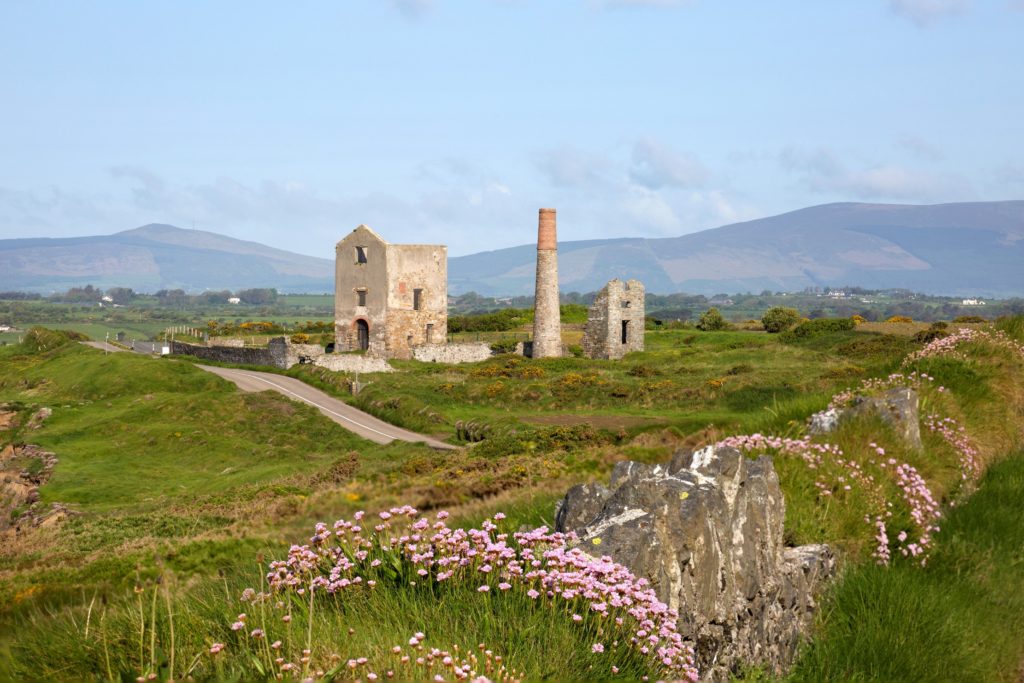Note: Here is part of the flesh and blood history of Bunmahon and Knockmahon.
We are lucky to have first person descriptions…fragmentary, earthy, nasty, quite wonderful.
No tome to do this all in one run thought..so here is Episode 76
alan
EPISODE 76 LIFE AS AN IRISH COPPER MINER IN BUNMAHON, COUNTY WATERFORD 1840 TO 1876
THE INVISIBLE PEOPLE

alan skeoch
June 2020
It is hard to visualize the life of an Irish copper miner at Knockmahon minion the 19th century.
The image that is locked in my mind is the darkness…absolute darkness as the hundreds of
miners descended on wooden ladder deep into the bowles of Knockmahon. And then when
they reached their various levels some of them proceeded southward in passageways excavated
under the sea. In the dark. With the steady trickling of sea water drip..drip..dripping. Suction
pumps driven by two steam engines far above the men tried to keep ahead of the water but
the miners must have known that a collapse of the ceiling would mean certain death.
Today, in 2020, those ancient workings are preserved intact by the very water that
threatened those miners. The darkness remains absolute.
Today, tourists can go underground at Knockmahon…the upper workings. Today Bunmahon is alive but not like it was in the 19th cetury It will never
be a copper mining community again. Which, I must say, is a good thing. You can go to Bunmahon and really imagine
what copper mining must have been like in those years between 1840 and 1875. And I hear the Bunmahon pub has
reopened so you can get a pint of Guinness which you would have had difficulty getting in the 1860’s.

An Irish historian, Des Cowman, has scrupulously researched life in these copper mines
His book encapsulates the lives of these men and women of the Bujmhahon 19th century
community.
I was rather surprised in 1960 to find that not one of our employees more anyone else
in Bunmahon seemed to have much knowledge about these miners. They just evaporated
into thin air. In reality the miners moved on…overwhelmingly they moved to the copper
mines of North America.
Below are snippets from the historical records unearthed by Des Cowman.
I will make a comment but I will try to present first hand evidence. It may seem a
bit chaotic but remember it is scraps like these that historians tell their tales.
THE SETTING
“A considerable stream of dirty water…very foul smell…flows down the Bonmahon hill
towards the shanty town…sand from the dunes blown into the gutters choking them so
the sewage accumulates in ponds and becomes stagnant…most cffensiveanddangeorus
to the health. Indeed, almost the entire population of this slum disappeared with the famine.”
Here stood 90 one-roomed bothans scattered along the road from Knockmahon…700 people…
39 of these bothans housed more than one family.
THE MINERS
I doubt there are any pictures of the real copper miners of Bunmahon. Photography
was rather experimental at the time. Why bother taking pictures of the lower class
when the upper class were so willing?
But we can find pictures that are darn close to the reality of Bunmahon…the depravity
will be missing. The strange things about most of these miners was their sobriety.
The Temperance Movement was a big success in Bunmahon. Not at first when 200
gallons of whisky was consumed on paydays. But early in the history of the community
whisky consumpition dropped to a gallon or two. And the pubs dropped from 21 to 1.
They built a Temperance Hall for $1,000 which became and is still the Catholic
Church in the old village of Knockmahon on the east bank of the Mahon River and
close to what was once the heart of the copper mine. Poor people, yes. For sure.

The miners exhibit the unmistakeable signs of debilited constitutions. Their faces are sallow, they
have an anxious expression in countenance and their bodies are thin. (1860’s British report on
Cornish Miners many of whom migrated to Knockmahon and Bunmahon.)
“At he border of middle age, or soon after, their health begins to fail, … they rapidly acqwjuire the feebleness
of declining years — A person of fifty is old for a miner.” (1860’s report to Br. parliament)
“debilitated constitutions” but not as bad as coal and lead miners. No methane to contend with for instance.
In1845 Knockmahon was 800 feet below the surface with about 70 work stations at various levels. Work
was done by six man crews who aced as independent subcontractors with the company. They agreed
to raise so many tons of ore at a fixed price with a bonus for overage. One month agreements…a kind
of auction of the ore-faces. Winners got the good ore faces. Competed with each other in other words.
Other six man teams hollowed out shafts, braced the walls…again by agreement to excavate so
much rock for a fixed price.
This system kept the miners and shaft diggers competing with each other. Not as employees of
the company.
THE DAILY ROUTINE
COMING NEXT….REALLY ALL PART OF EPISODE 76
